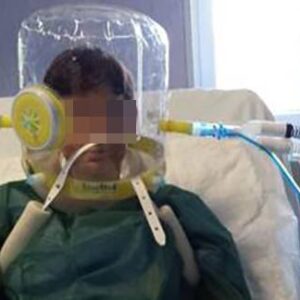86 years old lady was brought to ED with h/o SOB and productive cough for 3 days. Her past medical history included hypertension, ischaemic heart disease and severe osteoarthritis. She lived with her husband who was the main carer. Her mobility was limited due to arthritis.
On examination she was pyrexial (temp. 39.6 C), pulse rate 132, BP- 92/ 55, O2 saturation- 89% on 15 litres by non-rebreathing mask. ABG revealed type 1 respiratory failure with PO2 7.2 on 15 litres oxygen. Chest x ray showed consolidation in left lower lobe.
She was treated with intravenous antibiotics and IV fluids. She was reviewed by ITU team who suggested she was not a candidate for endotracheal intubation and ITU admission in view of comorbidities.
Is there any evidence of non-invasive ventilation for this group of patients?
In recent COVID 19 pandemic we have learned that there is robust evidence to support the use of non-invasive ventilation in COVID 19 pneumonitis to improve oxygenation.
I searched the literature whether this strategy can be utilised to improve oxygenation to non-COVID patients with hypoxaemic respiratory failure e.g., pneumonia.
My learning:
Recently a systematic review and meta-analysis was published in JAMA (July 2020) which included 25 randomised controlled trials and 3804 patients with acute hypoxemic respiratory failure [1].
These trials excluded patients with COPD and acute pulmonary oedema as usefulness of non-invasive ventilation is already established in these group.
It compared high-flow nasal oxygen, face mask non-invasive ventilation, helmet non-invasive ventilation, or standard oxygen therapy.
The primary outcome was all-cause mortality up to 90 days. A secondary outcome was endotracheal intubation up to 30 days.
Helmet non-invasive ventilation was the best in reducing all cause mortality (RR, 0.40 [95% CrI, 0.24-0.63]; absolute risk difference, −0.19 [95% CrI, −0.37 to −0.09] among all possible interventions.
This was followed by face mask non-invasive ventilation, high-flow nasal oxygen, and standard oxygen therapy.
There was no significant difference in the association with mortality when comparing face mask non-invasive ventilation with high-flow nasal oxygen.
Non-invasive oxygenation strategies compared with standard oxygen therapy were significantly associated with lower risk of death.
Non-invasive Oxygenation Strategies and Risk of Endotracheal Intubation
The probability of being best in reducing risk of endotracheal intubation was highest for helmet noninvasive ventilation, followed by face mask noninvasive ventilation, high-flow nasal oxygen, and standard oxygen therapy.
Bottom line:
This meta-analysis has empowered me to consider non invasive ventilation strategies in patients with hypoxaemic respiratory failure e.g., pneumonia. This is particularly pertinent in situations where patients were deemed not suitable for endotracheal intubation in view of comorbidities or functional status.
Here non-invasive ventilation gives better chances of recovery compared to standard oxygen therapy and this can be used as a ceiling of care.
Reference:
- Ferreyro BL, Angriman F, Munshi L, et al. Association of Noninvasive Oxygenation Strategies With All-Cause Mortality in Adults With Acute Hypoxemic Respiratory Failure: A Systematic Review and Meta-analysis. JAMA. 2020;324(1):57-67. doi:10.1001/jama.2020.9524

